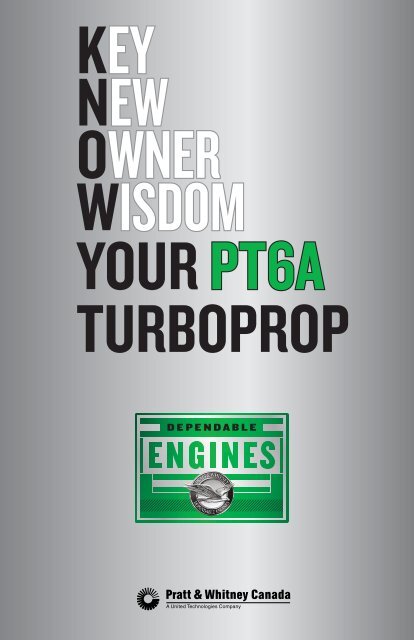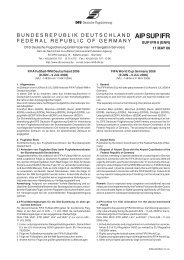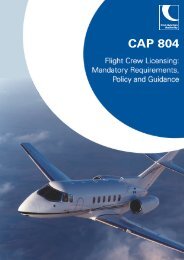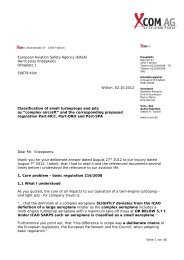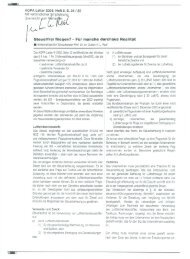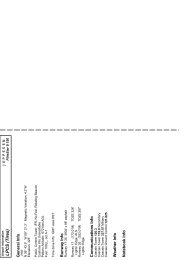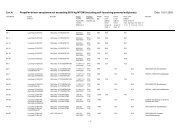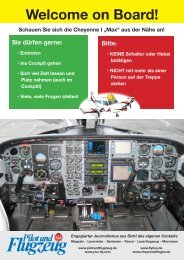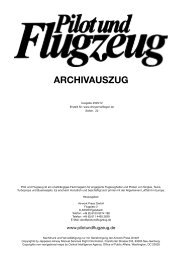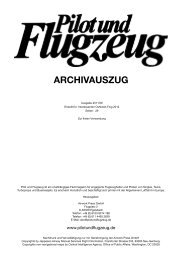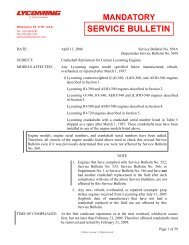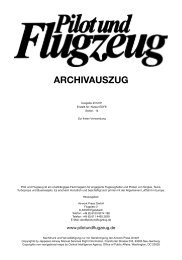Know your PT6A - Pratt & Whitney Canada
Know your PT6A - Pratt & Whitney Canada
Know your PT6A - Pratt & Whitney Canada
Create successful ePaper yourself
Turn your PDF publications into a flip-book with our unique Google optimized e-Paper software.
Key<br />
NEW<br />
OWNER<br />
WISDOm<br />
YOUR <strong>PT6A</strong><br />
turboprop
<strong>Know</strong> <strong>your</strong> pt6A turboprop<br />
Congratulations on <strong>your</strong> acquisition of an aircraft powered by the<br />
<strong>Pratt</strong> & <strong>Whitney</strong> <strong>Canada</strong> Corp. (P&WC) dependable <strong>PT6A</strong> Turboprop<br />
Engine! Just like you, operators around the globe have made the<br />
<strong>PT6A</strong> engines their choice in the business and general aviation<br />
market – engines known to provide exceptional power, performance<br />
and peace of mind. By making this wise choice, you are benefiting<br />
from 45 years and 300 million hours of in-service experience<br />
resulting in unmatched reliability.<br />
This handbook has been designed to give you a brief overview<br />
of the <strong>PT6A</strong> engine as well as some maintenance and power<br />
management recommendations. Always refer to the Pilots Operating<br />
Handbook (POH), Aircraft Flight Manual (AFM), Engine Maintenance<br />
Manual (EMM), Service Bulletin’s (SB) or other service information<br />
documentation for a complete text of the approved / recommended<br />
procedures and latest information.<br />
1
<strong>Know</strong> <strong>your</strong> pt6A turboprop<br />
Should you require additional information related to:<br />
AOG / critical emergency services<br />
Technical / maintenance consultation<br />
Warranty<br />
Publications<br />
Field Service Representative (FSR) contact info<br />
Rental Engines<br />
Engine status in any P&WC Service Centre<br />
Eagle Service Plan ® (ESP ® )<br />
AOG Parts After Hours,<br />
our Customer FIRST Centre is available 24 hours a day,<br />
7 days a week to assist you.<br />
In <strong>Canada</strong> and the United States:<br />
Tel: 1-800-268-8000<br />
International:<br />
Tel: International Access Code + 8000-268-8000<br />
Other Numbers:<br />
Tel: (450) 647-8000 Fax: (450) 647-2888<br />
Email:<br />
cfirst@pwc.ca<br />
Visit our website at:<br />
www.pwc.ca<br />
2
<strong>Know</strong> <strong>your</strong> pt6A turboprop<br />
Take note of <strong>your</strong> <strong>PT6A</strong> engine model and serial number.<br />
This will help us to coordinate our support in a timely manner.<br />
Engine Model:<br />
Engine Serial Number:<br />
Engine Logbook:<br />
Each engine is supplied with a logbook(s) to record all maintenance<br />
actions as well as engine running times and cycles. The logbook(s)<br />
must accompany the engine or module each time they are sent to an<br />
approved service or overhaul facility.<br />
3
Disclaimer<br />
Disclaimer<br />
The information contained herein has been set out in summary<br />
form and is provided for general reference purposes only and may<br />
be changed without prior notice. It should not be construed as<br />
creating any obligation on the part of <strong>Pratt</strong> & <strong>Whitney</strong> <strong>Canada</strong> Corp.<br />
While every care has been taken to avoid errors, <strong>Pratt</strong> & <strong>Whitney</strong><br />
<strong>Canada</strong> Corp. makes no representations about the accuracy of<br />
these guidelines and accepts no responsibility for any error herein.<br />
In no event shall P&WC be liable for any damages whatsoever<br />
resulting from the misuse, misinterpretation, analysis,<br />
interpretation or application of any of the guidelines contained<br />
herein. The information contained herein does not replace or<br />
supersede the information contained in the appropriate airframe or<br />
engine maintenance manuals or other official publications.<br />
Always refer to the Pilot’s Operating Handbooks (POH), Aircraft<br />
Flight Manuals (AFM), Engine Maintenance Manuals (EMM),<br />
Service Bulletins (SB) or other Service Information documentation<br />
for a complete text of the approved / recommended procedures<br />
and latest information.<br />
PT6 and <strong>PT6A</strong> are trademarks of <strong>Pratt</strong> & <strong>Whitney</strong> <strong>Canada</strong> Corp.<br />
© Copyright <strong>Pratt</strong> & <strong>Whitney</strong> <strong>Canada</strong> Corp. May not be reproduced, in whole<br />
or in part, without prior written consent<br />
5
Nomenclature<br />
ADAS<br />
AFM<br />
AGB<br />
AOG<br />
CT<br />
Aircraft Data Acquisition System<br />
Aircraft Flight Manual<br />
Accessory Gearbox<br />
Aircraft On Ground<br />
Compressor Turbine<br />
ECTM ® Engine Condition Trend Monitoring ®<br />
EESP<br />
EPL<br />
Extended Engine Service Policy<br />
Emergency Power Lever<br />
ESP ® Eagle Service Plan ®<br />
FOD<br />
FSR<br />
HSI<br />
ITT<br />
LCF<br />
MOR<br />
Ng<br />
Foreign Object Damage<br />
Field Service Representative<br />
Hot Section Inspection<br />
Interturbine Temperature<br />
Low Cycle Fatigue<br />
Manual Override<br />
Gas Generator Speed<br />
6
Nomenclature<br />
Np<br />
PPSP<br />
PLA<br />
POH<br />
PT<br />
RPM<br />
SB<br />
SHP<br />
SIL<br />
STOL<br />
TBO<br />
TSO<br />
TTSN<br />
TCSN<br />
UAC<br />
Wf<br />
Propeller Speed<br />
Primary Parts Service Policy<br />
Power Lever Assembly<br />
Pilot’s Operating Handbook<br />
Power Turbine<br />
Rotations Per Minute<br />
Service Bulletin<br />
Shaft Horsepower<br />
Service Information Letter<br />
Short Takeoff and Landing<br />
Time Between Overhaul<br />
Time Since Overhaul<br />
Total Time Since New<br />
Total Cycles Since New<br />
United Aircraft Corporation<br />
Fuel Flow Rate<br />
7
<strong>Know</strong> <strong>your</strong> pt6A turboprop<br />
Initial Customer Support Presentation<br />
P&WC offers a three-part introduction to the company, engine maintenance<br />
and our aftermarket support logistics. You have the option of scheduling a<br />
meeting at <strong>your</strong> convenience or we will be happy to send you an information<br />
kit with brochures and a copy of the presentation that you may review at<br />
<strong>your</strong> leisure. When the time comes, <strong>your</strong> local FSR can provide guidance<br />
on such things as fuel nozzle exchange, boroscope inspection of the hot<br />
section or other maintenance areas.<br />
Publications<br />
P&WC offers a package of high-quality technical publications for new<br />
aircraft operators. Moreover, a free two-year revision service is provided<br />
for each new publications subscription. Additional publications may also<br />
be purchased. The price list for commercial publications is available upon<br />
request by contacting Publications Customer Services.<br />
For additional details on our Technical Publications, including contact info,<br />
please visit us at our website, www.pwc.ca<br />
Warranty<br />
P&WC prides itself in offering transferable warranty coverage that is<br />
amongst the best in the aerospace business. The new engine warranty is<br />
comprised of the Basic Coverage Period and may be supplemented by one<br />
or both of the following available service policies:<br />
· The Primary Parts Service Policy (PPSP) is a renewable pro-rata warranty<br />
coverage for the repair or replacement of specific engine parts damaged<br />
due to a defect in material or manufacturing workmanship during their<br />
P&WC commercially-supported class life.<br />
· The Extended Engine Service Policy (EESP) applies for a premature,<br />
engine-chargeable event when an overhaul is required.<br />
8
<strong>Know</strong> <strong>your</strong> pt6A turboprop<br />
Once we have been informed of a new <strong>PT6A</strong> engine delivery to an aircraft<br />
operator, a copy of the applicable new engine warranty will be sent<br />
to the new owner by the P&WC Warranty Administration department.<br />
Notification of new aircraft sales is normally received directly from aircraft<br />
manufacturers, their licensed dealers or directly from the owner. Note<br />
that warranty coverage is attached to the engine serial number, not to<br />
the owner. For any warranty questions, please feel free to email us at<br />
warranty@pwc.ca.<br />
If <strong>your</strong> aircraft is involved in an incident which affects the engine (e.g. prop<br />
strike, hard landing), you must inform P&WC Warranty by filling out the<br />
form included in SIL GEN-039. This will ensure that <strong>your</strong> warranty policy is<br />
reinstated following the corrective maintenance actions.<br />
Customer Portal<br />
<strong>Pratt</strong> & <strong>Whitney</strong> <strong>Canada</strong> is committed to providing global support services<br />
that delights our customers. The P&WC Customer portal is just one of the<br />
many ways in which we collaborate with our customers. The portal will give<br />
access to an increasing list of on-line services and information.<br />
Register today on our website, www.pwc.ca, free of charge, to receive<br />
the P&WC Extranet Application URL, username and password once the<br />
registration request has been approved and processed.<br />
9
<strong>PT6A</strong> engine General<br />
<strong>PT6A</strong> Engine Overview<br />
Unmatched versatility, dependability and performance have made the <strong>PT6A</strong><br />
engine the most thoroughly proven and popular turboprop engine family<br />
in the 500- to 1,700-shp class, covering a diverse range of applications<br />
across all aircraft markets. We continually invest in technology to make our<br />
engines the most environmentally friendly and to offer even greater value in<br />
the form of higher performance and digital engine control.<br />
The PT6 engine, a lightweight free turbine engine incorporating a reverse<br />
flow combustion path, is designed for aircraft propulsion use. It utilizes two<br />
counter-rotating turbines; one driving the compressor and the other driving<br />
the propeller through a reduction gearbox. The latter turbine is “free”<br />
or independent of the compressor turbine. More recent, higher powered<br />
models incorporate a two-stage power turbine.<br />
Over the years, the PT6 engine has evolved and adapted to a multitude of<br />
uses. The <strong>PT6A</strong> engine is the turboprop designation, powering commuter,<br />
corporate and utility aircraft, aerobatic trainers, agricultural aircraft, short<br />
takeoff and landing (STOL) aircraft and water bombers. This handbook is<br />
dedicated to the <strong>PT6A</strong> variant.<br />
The PT6B, C & T (Twin-Pac®) engines are turboshaft variants, providing<br />
reliable power to many of the worlds helicopters and more recently to<br />
tiltrotors.<br />
The ST6 engine is an industrial variant of the PT6 engine, originally<br />
developed for the United Aircraft Corporation (UAC) TurboTrain and<br />
intended for stationary application.<br />
10
Modularity<br />
The design of the <strong>PT6A</strong> engine allows it to be split into two major parts<br />
called the power section assembly and the gas generator assembly. Only<br />
certain engine models are defined as being modular, which allows the<br />
interchange and tracking of each module. Three criteria must be met for the<br />
engine to be modular.<br />
1. Each major assembly is equipped with a data plate and a third data<br />
plate is located on the inlet case for the complete engine assembly.<br />
2. There is a logbook for each module.<br />
3. In the appropriate SB on service lives, there will be an overhaul interval<br />
quoted for each module and the engine assembly.<br />
On non-modular <strong>PT6A</strong> engines, the power section assembly can be removed<br />
and sent for service, but must be returned and installed on the same gas<br />
generator assembly.<br />
Small <strong>PT6A</strong> Engine<br />
11
Advantages of the <strong>PT6A</strong> engine Design<br />
A number of advantages are derived from the design of the <strong>PT6A</strong> engine<br />
which have proven valuable in routine field operation.<br />
During an engine start, only the compressor section of the <strong>PT6A</strong> engine<br />
needs be rotated by the starter-generator. By comparison, a fixed-shaft<br />
engine must spin all rotating components including the reduction gearbox<br />
and propeller during an engine start, resulting in a requirement for heavier<br />
starting systems.<br />
The <strong>PT6A</strong> engine free turbine design allows the propeller RPM to be reduced<br />
and the propeller feathered during ground operation without shutting<br />
down the engine. This facilitates fast passenger loading and permits very<br />
quiet ground operation. Propeller RPM can also be varied in flight (on most<br />
applications) permitting propeller RPM to be set for quieter cruise and<br />
optimum efficiency.<br />
12
Principles of Operation<br />
The <strong>PT6A</strong> engine consists of two main sections, the gas generator section<br />
and the power section.<br />
The gas generator section compresses and delivers air to the combustion<br />
chamber where it is mixed with fuel and ignited. The resulting hot gases<br />
turn the compressor turbine which provides the power to run the compressor<br />
and the accessory gearbox located at the rear of the engine. The hot gases<br />
continue on to the power turbine where the remaining energy is extracted to<br />
turn the propeller.<br />
Np Tq<br />
Nf T5 (ITT) Ng<br />
FCU<br />
Wf<br />
13
Airflow<br />
Air is directed to a compressor consisting of three axial stages (Four<br />
axial stages on large <strong>PT6A</strong> engine models) and one centrifugal stage.<br />
Compressed air leaving the compressor passes through diffuser pipes<br />
which turn the flow 90 degrees, reduce its speed and direct the air into the<br />
combustion chamber.<br />
In the annular combustion chamber the air is mixed with fuel and burned.<br />
Two igniter plugs are used to light the fuel/air mixture when the engine is<br />
started. They are not required to maintain the combustion process and can<br />
be shut off once the engine has reached idle speed.<br />
The expanding hot gases are directed first through the compressor turbine<br />
and then through the power turbine. After passing through the power<br />
turbine, the gases are exhausted through ports on each side of the engine.<br />
(Some engines are fitted with a single-port exhaust.) The exhaust stubs<br />
fitted to the engine are normally directed to utilize the remaining energy of<br />
the gases in the form of thrust for additional aircraft propulsion.<br />
Two bleed air systems are incorporated in the <strong>PT6A</strong> engine. Automatic bleed<br />
air from the compressor prevents compressor stall during acceleration from<br />
low engine speeds or deceleration from high engine speeds. For aircraft<br />
use, air may be bled for heating or pressurizing aircraft cabins.<br />
Medium <strong>PT6A</strong> Engine<br />
14
Power Train<br />
A shaft connects the power turbine to the two-stage planetary reduction<br />
gearbox. The first stage reduction ring gear floats axially against a hydraulic<br />
torquemeter cylinder. The oil pressure in this cylinder is proportional to<br />
output torque which is displayed on the torque indicator in the cockpit.<br />
Bevel gears located forward of the second stage planetary gears drive the<br />
following accessories mounted on the forward reduction gearbox case:<br />
· propeller governor or constant speed unit<br />
· propeller overspeed governor<br />
· tachometer-generator<br />
2 ND STAGE<br />
REDUCTION<br />
GEAR<br />
1 ST STAGE<br />
REDUCTION<br />
GEAR<br />
POWER<br />
TURBINES<br />
COMPRESSOR<br />
TURBINE<br />
COMPRESSOR<br />
ACCESSORY<br />
GEARBOX<br />
PROPELLER<br />
SHAFT<br />
Large <strong>PT6A</strong> Engine<br />
The accessory gearbox, mounted on the rear of the engine, is used to drive<br />
the following engine accessories:<br />
· High-pressure fuel pump<br />
· Fuel control unit<br />
· Oil scavenge and oil pressure pumps.<br />
Space is also provided for aircraft manufacturer provided accessories such<br />
as the starter-generator, gas generator tachometer-generator, fuel boost<br />
pumps or hydraulic pumps.<br />
15
Bearings<br />
Support of the main shafts in the <strong>PT6A</strong> engine is accomplished by a<br />
combination of ball and roller bearings. Ball bearings support axial and<br />
radial loading, while the roller bearings support only radial loads, allowing<br />
for thermal expansion.<br />
Propeller Shaft Power Turbine Compressor<br />
No. 5: Roller No. 3: Roller No. 1: Ball<br />
No. 6: Ball No. 4: Ball No. 2: Roller<br />
No. 7: Roller**<br />
** Smaller reduction gearboxes do not utilize a No. 7 bearing.<br />
7 6 5<br />
A-60<br />
A-65<br />
A-67<br />
A-52<br />
A-61<br />
A-64<br />
A-66<br />
6 5 4 3 2 1<br />
16
FOD Protection<br />
Inertial Separator<br />
The nacelle inlet of many aircraft models includes an inertial separator<br />
provided by the aircraft manufacturer to prevent heavy particles from<br />
entering the engine inlet. Most installations incorporate two moveable<br />
vanes, one upstream of the engine inlet and the other blocking the bypass<br />
duct. For bypass operation, the inlet vane is lowered and the bypass<br />
duct vane is opened permitting maximum separating efficiency. In some<br />
installations, the vanes are fixed in the bypass mode.<br />
As shown in the sketch, air entering the engine inlet must turn sharply past<br />
the inlet vane (shown in the lowered position). Particles heavier than air<br />
are carried straight through, by their own inertia, into the bypass duct and<br />
dumped overboard.<br />
The aft radial inlet design provides many advantages such as superior<br />
anti-icing utilizing the principle of inertial separation, low noise levels and<br />
unequalled protection from FOD.<br />
BYPASS (ICING)<br />
POSITION<br />
NORMAL<br />
POSITION<br />
17
Fuel System<br />
The fuel system is designed to deliver clean fuel to the engine at the<br />
pressure and flow that are necessary for all engine operating conditions.<br />
The airframe fuel system contains the necessary boost pumps, transfer<br />
pumps, selector/shutoff valves, strainers and filters required to supply fuel<br />
to the engine(s) and to manage the fuel load distribution in the airplane.<br />
The engine is equipped with a fuel system which consists of a fuel heater,<br />
high-pressure fuel pump, fuel filter, fuel control unit, start control or flow<br />
divider unit and a manifold with fuel injection nozzles.<br />
The fuel control unit is either a hydro-pneumatic or a hydro-mechanical<br />
system which meters the correct amount of fuel to the engine to maintain<br />
the gas generator speed selected by the pilot via the power control lever. It<br />
also controls fuel flow scheduling during engine starting, acceleration and<br />
deceleration.<br />
The <strong>PT6A</strong> engine is approved for operation with all commercial jet fuels,<br />
JP-4, JP-5 and for a maximum of 150 hours during any overhaul period with<br />
all grades of aviation gasoline. Specific grades of diesel fuel are approved<br />
as alternate fuels for restricted use. No engine adjustments are required<br />
in changing from one fuel to another, nor is it necessary to purge the fuel<br />
system when changing fuels, except when using alternate fuels.<br />
For listings of approved fuels and fuel additives refer to the appropriate<br />
Service Bulletins for each <strong>PT6A</strong> engine model.<br />
18
Oil System<br />
The <strong>PT6A</strong> engine has a self-contained oil system with the exception of the<br />
oil cooler, air duct and associated plumbing. The oil level should be verified<br />
after engine shutdown and while the oil is still hot, using either a dipstick<br />
or a sightglass.<br />
For more information related to the oil system, please refer to page 29.<br />
19
Typical <strong>PT6A</strong> Engine Instrumentation<br />
Incorporated into the design of the <strong>PT6A</strong> engine are accurate and reliable<br />
torque and ITT measuring systems that give the pilot an accurate<br />
indication of the primary engine operating parameters.<br />
Torque Pressure is sensed by a torque pressure transducer mounted on the<br />
reduction gearbox, to indicate the torque being developed by the engine.<br />
Torque is the primary parameter used to set power for takeoff and cruise<br />
operation for specified propeller speeds.<br />
ITT is monitored to ensure that combustion gas temperature limits of the<br />
engine are not exceeded.<br />
Two tachometer-generators are installed on the engine: one on the<br />
reduction gearbox monitors propeller speed (Np), and the other on the<br />
accessory gearbox monitors gas generator speed, (Ng).<br />
Pressure and temperature gauges monitor the oil system.<br />
20
Controls<br />
Cockpit Powerplant Controls<br />
<strong>PT6A</strong> engine applications use the engine power management system<br />
and propeller beta control capability to obtain optimum airplane flight<br />
and ground handling capability. The powerplant functions are typically<br />
commanded from the cockpit by means of three control levers and pushpull<br />
cables.<br />
In some applications where certain powerplant functions are not required,<br />
simplified systems using two or even one cockpit control lever may be used.<br />
REVERSE<br />
POWER<br />
LEVER<br />
CAM ASSY<br />
TAXI<br />
RANGE<br />
BETA<br />
MIN. POWER<br />
POWER<br />
RANGE<br />
MAX. POWER<br />
MIN. RPM<br />
FEATHER<br />
PROPELLER<br />
LEVER<br />
PROPELLER GOVERNOR<br />
MAX. RPM<br />
SHUT-OFF<br />
LOW IDLE<br />
HIGH IDLE<br />
FUEL<br />
LEVER<br />
Control Location Control Function<br />
Condition<br />
Fuel control unit<br />
(or start control)<br />
Fuel cut-off and idle<br />
speed(s)<br />
Power Fuel control unit Gas Generator speed<br />
Propeller Propeller governor Prop speed and feathering<br />
21
CONTROLS<br />
Secondary control inputs located on the propeller governor include the beta<br />
valve and the fuel governor reset. These controls are used in conjunction<br />
with the propeller low blade angle feedback system and the engine<br />
propeller reversing control system for propeller beta control and reverse<br />
thrust control. A cambox unit is part of the engine control system and its<br />
purpose is to schedule gas generator speed and propeller angle by means<br />
of linkages to the fuel control power lever and to the propeller governor<br />
beta valve and fuel governor reset controls.<br />
Propeller Low Blade Angle Reset Systems<br />
During the development program of an airplane, the most desirable<br />
propeller low pitch limits (primary blade angle) and engine flight idle<br />
settings required for optimum flight handling are determined. In some<br />
cases, certain ground operating requirements such as propeller restricted<br />
speed ranges may dictate a different propeller low pitch limit for ground<br />
operation. Some installations utilize an airframe-supplied propeller low<br />
pitch reset system actuated by means of a switch which senses the weight<br />
of the airplane on the main landing gear. This functionality is integrated<br />
with the engine-supplied propeller beta control system. The system<br />
automatically sets the propeller low pitch limit to either the ground or<br />
light positions.<br />
Automatic Feathering<br />
Takeoff performance for multi-engine aircraft is based upon having one<br />
engine inoperative. Most multi-engine aircraft are equipped with aircraft<br />
manufacturer provided automatic feathering systems to reduce drag on<br />
the aircraft. However these systems are normally not armed during most<br />
other phases of flight. Automatic feathering is not used in single-engine<br />
<strong>PT6A</strong> engine applications. Please refer to the applicable AFM for specific<br />
operating instructions.<br />
Because the free turbine configuration of the <strong>PT6A</strong> engine has less rotating<br />
inertia than a fixed turbine engine, an unfeathered propeller creates less<br />
in-flight drag. Therefore, negative torque sensing systems are not required.<br />
22
CONTROLS<br />
Propeller Overspeed Governor<br />
All <strong>PT6A</strong> turboprop installations are equipped with an airframe-supplied<br />
propeller overspeed governor. This unit has its own dedicated drive from<br />
the engine reduction gearbox and is intended to limit the propeller speed<br />
to a predetermined maximum value in the event of a malfunction of the<br />
primary propeller governor.<br />
In most installations which feature an automatic feathering system, the<br />
automatic propeller feathering function is performed by an electricallyactivated<br />
propeller servo oil dump valve on the overspeed governor.<br />
Overtorque Limiter<br />
On some <strong>PT6A</strong> engine installations an overtorque limiter is installed<br />
to limit maximum engine output torque to a preset value. This function<br />
has been utilized on applications where the normal power setting and<br />
monitoring procedures cannot be used, such as military trainer aircraft<br />
which are intended to maintain the maximum operational similarity to<br />
high-performance jet aircraft. Other applications with substantially flat<br />
rated <strong>PT6A</strong> engines utilize an overtorque limiter to prevent inadvertent<br />
excessive power settings by the pilot.<br />
An electronic limiter system is also installed on some engine models<br />
intended for military trainer aircraft. This system offers both torque and<br />
ITT limiting capability.<br />
Manual Override<br />
All <strong>PT6A</strong> engines intended for single-engine aircraft are equipped with a<br />
manual override function installed on the fuel control unit. The manual<br />
override can be connected to an Emergency Power Lever (EPL) in the<br />
cockpit by an airframe-supplied linkage, if required by the aircraft<br />
manufacturer.<br />
23
Emergency power lever<br />
Introduction<br />
The manual override function, when connected to the EPL, is intended for<br />
use during emergencies or closely monitored training only and must never<br />
be used during normal engine operation.<br />
This lever should only be used to modulate engine power to allow the pilot<br />
to continue flight to the nearest airport in the event of malfunction in the<br />
fuel control pneumatic system resulting in one of the following conditions:<br />
1. Uncommanded power roll back and inability to recover with the<br />
Power Lever Assembly (PLA).<br />
2. No response to PLA movement, when starting from or around idle.<br />
3. PLA becomes stuck at or around idle.<br />
The EPL does not duplicate the function of the PLA and is not to be used as<br />
an optional means of controlling the engine.<br />
The EPL overrides all automatic fuel control features and acts directly<br />
on the fuel valve to directly modulate the fuel flow to the engine. Rapid<br />
movements of this lever should not be made for any reason whatsoever.<br />
EPL sensitivity increases with altitude and above 5000 ft., extreme care<br />
should be exercised.<br />
Please refer to the applicable AFM or POH for correct operation of the EPL.<br />
CAUTION:<br />
WHEN USING THE MANUAL OVERRIDE SYSTEM, THE ENGINE RESPONSE<br />
MAY BE MORE RAPID THAN WHEN USING THE POWER LEVER. A RAPID<br />
INCREASE IN EMERGENCY POWER LEVER POSITION TOWARDS MAXIMUM<br />
IS TO BE AVOIDED, AS THIS CAN CAUSE ENGINE SURGE, ENGINE OVER-<br />
TEMPERATURE, Ng OVER-SPEED OR OVER-TORQUE.<br />
Inappropriate use of the EPL will increase maintenance costs and can be a<br />
contributory factor to CT blade fractures.<br />
24
Scheduled Maintenance<br />
The following information is intended as an overview of maintenance<br />
practices. For a complete description please refer to the Engine<br />
Maintenance Manual (EMM).<br />
Chapter 70-00-00 describes standard practices including servicing the<br />
engine oil system.<br />
Chapter 71-00-00 contains information on maintenance practices,<br />
including adjustment, test and cleaning.<br />
Chapter 72-00-00 outlines inspection criteria for various sections of the<br />
engine.<br />
The inspection procedures are considered a normal function of the<br />
operating organization and are intended as a guide for minimum<br />
inspection and maintenance requirements. The aircraft manufacturer<br />
may have additional requirements or suggest different service intervals.<br />
See the airframe maintenance manual for details.<br />
25
Engine Inspections<br />
Chapter 72-00-00, Table 601, of the EMM contains the minimum<br />
recommendations for regular inspections of the engine. There are two<br />
primary intervals, ROUTINE and MINOR. More precise intervals are used for<br />
specific components when required.<br />
· ROUTINE inspections coincide with the daily or preflight airframe<br />
inspection.<br />
· MINOR inspections coincide with a typical airframe zone inspection.<br />
The intervals at which these inspections are performed may be altered<br />
by the aircraft manufacturer’s maintenance program and approved by<br />
the operator’s local airworthiness authority. Engines operating in sandy<br />
or dusty environments or in smog or salt-laden atmospheres should be<br />
subjected to additional inspections for corrosion and compressor erosion.<br />
The engine maintenance manual quotes recommended intervals, which the<br />
operator can adjust, based upon operating experience. Typical maintenance<br />
actions include:<br />
· Engine washing<br />
- Compressor Desalination Wash<br />
- Compressor Turbine Desalination Wash<br />
- Compressor Performance Recovery Wash<br />
· Foreign Object Damage (FOD) inspection of the compressor<br />
- Inspection of Compressor Inlet Case for corrosion<br />
- Inspect the fuel system based upon environment and fuel quality<br />
- In-situ fuel nozzle cleaning<br />
- Fuel nozzle inspection, cleaning and tip replacement<br />
- Ignition system<br />
- Oil system flush<br />
- Borescope inspection of combustion chamber, compressor turbine<br />
vane and blades<br />
Two areas of the <strong>PT6A</strong> engine have no scheduled maintenance intervals:<br />
· Reduction gearbox<br />
· Propeller control system<br />
26
Oil System Inspection and Servicing<br />
Oil Level Sightglass<br />
Some <strong>PT6A</strong> engine models are equipped with a sightglass to simplify the<br />
inspection of the engine oil level. The sightglass has a centre green zone<br />
with red on each end. Engine operation is permitted with the oil level at any<br />
point in the green zone. The oil level dipstick must be checked when the oil<br />
level is in either the red zone or is not visible in the sightglass.<br />
Oil Level Check<br />
Oil level should be checked regularly and replenished as necessary.<br />
Although consistency is the most important factor when establishing a<br />
schedule for checking the oil level, P&WC recommends this check be done<br />
15 minutes after every shutdown.<br />
Oil Replenishment<br />
P&WC recommends that the engine not be filled over the “MAX COLD” level<br />
on the oil level dipstick. This corresponds with the centre of the green band<br />
on the oil level sightglass. A high oil level may result in an increase in<br />
either the oil consumption rate or the amount of oil mist passing through<br />
the engine oil breather. Each engine will seek its own normal operating oil<br />
level.<br />
Space is required in the oil tank for expansion as the oil reaches full<br />
operating temperature. If the oil level is over the “MAX HOT” level, drain<br />
some of the oil. Refer to the EMM for complete instructions.<br />
A listing of approved oils is provided in the appropriate Service Bulletins for<br />
each <strong>PT6A</strong> model. When switching to another approved oil brand or should<br />
oil of different brands or viscosities become mixed it is necessary to drain<br />
and flush the complete oil system.<br />
27
Oil System Inspection and Servicing<br />
Oil Temperature and Colour<br />
High oil temperature will accelerate the accumulation of carbon particles<br />
in the oil and the deterioration of oil additives. Oil colour will darken with<br />
usage and exposure to light. The rate of colour change is dependent upon<br />
the oil manufacturer’s formula. A darkening of the oil does not indicate<br />
deterioration in the lubricity of the base stock. Additives are replenished<br />
with the addition of oil during level servicing.<br />
Chip Detectors<br />
All <strong>PT6A</strong> engines are fitted with an RGB chip detector, while some models<br />
also have a chip detector in the AGB housing. AGB chip detectors are not<br />
equipped with a self-closing valve. When the chip detector is removed,<br />
the oil in the accessory gearbox will drain from the engine. During normal<br />
operation, there will be approximately ½ litre (17 oz.) of residual oil.<br />
Chip detectors should be checked regularly for continuity and any foreign<br />
material. If the aircraft is equipped with a cockpit indication of the chip<br />
detector, the whole system should also be checked regularly. Refer to the<br />
applicable maintenance manuals for inspection intervals.<br />
Oil Filter Debris Analysis<br />
The oil filter must be changed or cleaned at scheduled intervals. At the<br />
same time a visual inspection of the oil filter and chip detectors should<br />
be done. This is a simple and reliable method of assessing the wear of<br />
oil-wetted parts. As an extra step, a solvent may be used to flush trapped<br />
particles from the engine oil filter. The solvent is poured through filter paper<br />
to collect the debris. This is referred to as a filter “patch” check.<br />
The filter paper is sent to a laboratory for analysis. Laboratory techniques<br />
can be used to determine the alloy of the particles which helps determine<br />
their source. With successive samples, a wear trend for oil-wetted parts<br />
can be established.<br />
28
Performance Check<br />
Over the life of the <strong>PT6A</strong> engine, the performance charts have evolved in<br />
name, style and function. Today, a variety of charts can be found. They<br />
may be titled Power Assurance Check, Performance Check or Ground Power<br />
Check charts. The charts allow operators of <strong>PT6A</strong> engines to monitor the<br />
condition of their engines and the results of maintenance actions.<br />
The chart may be used over a wide range of ambient temperature and<br />
altitude.<br />
The chart is intended to indicate when maintenance action might be<br />
required and the results of the repair when data is recorded before and<br />
after the maintenance action. With regular use, the chart can become a<br />
useful tool for scheduling maintenance.<br />
Check charts do not appear in all engine maintenance manuals. Some of<br />
them are published in the airframe maintenance manual.<br />
The performance check is influenced by the powerplant as a whole, not just<br />
the engine. The effects of poor nacelle seals, bleed air leaks, accessory<br />
drive power and instrumentation errors are all reflected in the recorded<br />
data.<br />
Do not use the chart to reject engines from service. Engines may remain<br />
in service provided that no operating limits are exceeded at the certified<br />
powers. P&WC recommends that troubleshooting and a flight test be done<br />
at the typical flight altitude to determine engine serviceability and that any<br />
step changes in parameters be investigated.<br />
The performance check charts are based upon estimated “average” engine<br />
performance. Every engine has its own unique characteristics. On certain<br />
types of performance check charts, this will affect the slope of the lines. By<br />
recording data at a few different ambient temperatures, within a short time<br />
of each other, the slope for a particular engine can be determined. P&WC<br />
recommends that this be done soon after aircraft delivery to establish a<br />
baseline for investigating future, performance-related issues.<br />
29
Engine Washing<br />
Atmospheric pollutants may contaminate the engine gas path, leading to<br />
a build up of deposits on airfoils, the initiation of corrosion, sulphidation<br />
or performance deterioration. These effects can be alleviated with engine<br />
washing. Internal engine washes are done while motoring the engine at<br />
10-25% Ng speed for a thorough cleaning.<br />
Compressor Desalination Wash<br />
Used to remove salt deposits which can cause corrosion, however light<br />
dirt deposits may also be removed. Wash fluid is drinking quality water,<br />
provided minimum standards are met. Water is injected into the engine<br />
intake using either an installed compressor wash ring or a hand held<br />
wash wand.<br />
Compressor Turbine Desalination Wash<br />
Used to remove salt deposits from the compressor turbine blades and<br />
stator which can cause sulphidation, a reaction between the salt and<br />
sulphur from the fuel. This wash must be done immediately following a<br />
compressor desalination or performance recovery wash as contaminants<br />
will be transferred from the compressor to the hot section during a<br />
compressor desalination or performance recovery wash. Wash fluid is<br />
drinking quality water, provided minimum standards are met. Water is<br />
injected through a wash tube inserted through one of the ignitor ports.<br />
Compressor Performance Recovery Wash<br />
Used to remove more stubborn deposits which cannot be removed during<br />
normal desalination washes. Wash fluid includes an approved detergent.<br />
This wash should only be done when engine performance loss is noticeable<br />
or trend monitoring dictates. Wash fluid is injected into the engine intake<br />
using either an installed compressor wash ring or a hand held wash wand.<br />
A water rinse of both the compressor and compressor turbine is required<br />
following the detergent wash.<br />
30
Engine Washing<br />
External Engine Wash<br />
Used as an effective method of tracing oil leaks, as well as removing salt<br />
and other environmental contaminants from the engine external surfaces.<br />
Wash fluid is drinking quality water, provided minimum standards are met.<br />
Wash Schedule<br />
When operating continuously in a salt laden environment (typically within<br />
10 nautical miles from the sea and under 10,000 ft), it is recommended<br />
to perform compressor and compressor turbine desalination washes and<br />
external washes daily, after the last flight of the day to prevent corrosion<br />
from initiating overnight. For occasionally salt laden operation, weekly<br />
desalination washes and external washes are recommended. Performance<br />
recovery washes are only recommended when a noticeable performance<br />
shift is recorded. In all cases, engine washing frequency should be based<br />
on operator experience and regular inspections of engine components to<br />
check for initiation of corrosion.<br />
Refer to P&WC SIL <strong>PT6A</strong>-144 for additional information and FAA Advisory<br />
Circular 43-4A for a comprehensive overview of corrosion. On the next page<br />
you will find a map of North America showing areas where environmental<br />
conditions will require particular attention to corrosion. Maps of the rest of<br />
the world can be found in the above mentioned Advisory Circular.<br />
31
Engine Washing<br />
Fairbanks<br />
Anchorage<br />
Seattle<br />
Montreal<br />
Los Angeles<br />
Denver<br />
New York<br />
Corrosion Severity Zone<br />
Mild<br />
Moderate<br />
Severe<br />
Mexico<br />
Dallas<br />
Atlanta<br />
Houston<br />
Miami<br />
Havana<br />
Haiti Puerto Rico<br />
Jamaica St. Domingo<br />
Figure 1<br />
North American Corrosion Severity Map,<br />
extracted from FAA Advisory Circular 43-4A,<br />
32
Hot Section Inspection<br />
A Hot Section Inspection (HSI) is usually done halfway through the basic<br />
TBO interval or when performance loss dictates. This involves splitting the<br />
engine between the compressor and power turbines at “C” Flange. Since it<br />
is generally not necessary to remove the engine from the aircraft during an<br />
HSI, the inspection procedure is both simple and fast.<br />
33
Overhaul<br />
The basic Time Between Overhaul (TBO) and Hot Section Inspection (HSI)<br />
interval is published in the appropriate Service Bulletin for each <strong>PT6A</strong><br />
engine model. Under extreme conditions, maintenance action prior to the<br />
recommended overhaul life may be necessary.<br />
The TBO interval depends on the specified operation of the engine.<br />
The interval can be escalated incrementally with the approval of <strong>your</strong><br />
airworthiness authority, using an “on-condition” or a sampling program.<br />
The current TBO escalation is limited at 8,000 hours for single-engine<br />
aircraft and 10,000 hr to 12,500 hr, for twin-engine aircraft, depending on<br />
the application.<br />
TBO escalation recommendations take into account the average effect<br />
of flight duration, time at a given power level, climate, environment,<br />
maintenance practices, utilization and engine hardware standard.<br />
34
Cycle Counting<br />
Certain rotating components of the engine have a limited life based upon<br />
the number of operating cycles they experience. These lives are quoted<br />
in the Rotating Component Lives Service Bulletin for each <strong>PT6A</strong> engine<br />
model. It is important to continuously record the number of operating cycles<br />
and partial cycles to track rotor lives. Rotor components not supported<br />
by proper documentation are to be removed from service. Prior to engine<br />
servicing, the total cycles and all flights and starts must be recorded in the<br />
appropriate engine logbook.<br />
At engine overhaul, a calculation will be made of the remaining service life<br />
for each rotating component. This calculation is based upon the rate of<br />
cycle accumulation recorded in the engine logbook.<br />
35
Engine Condition Trend Monitoring®<br />
ECTM ® is a computer software program sold by P&WC that assists in early<br />
detection of potential problems through continuous monitoring of engine<br />
operation. The advantage of using ECTM ® is a savings in troubleshooting<br />
time, reduced maintenance costs, the ability to schedule corrective action<br />
and an increased dispatch rate.<br />
The pilot or an on-board monitoring system must record the readings of the<br />
aircraft and engine gauges after the aircraft has been flying at a stable<br />
cruise condition for several minutes. Gauge readings are to be recorded<br />
daily or once per flight. Alternatively, you may send <strong>your</strong> recorded trend data<br />
to a designated analysis centre for processing and recommendations.<br />
Accurate and consistent readings are crucial to effective trend monitoring;<br />
the quality of the engine condition evaluation is only as good as the quality<br />
of the data provided.<br />
On-board data recording<br />
Altair Avionics markets a <strong>PT6A</strong> engine-mounted data recording system<br />
called TrendCheck Plus+, and the Aircraft Data Acquisition System (ADAS),<br />
an airframe-mounted engine monitor, for a wide variety of <strong>PT6A</strong> engine<br />
applications. These monitors enhance safety and reduce direct operating<br />
costs through sophisticated aircraft exceedance monitoring and automated<br />
trend sample collection. Operated in conjunction with Altair’s internetbased<br />
TurbineTracker system, these monitors are a powerful diagnostic<br />
tool and engine health monitor.<br />
While both systems monitor the engine parameters of turbine temperature,<br />
gas generator speed, power turbine speed, torque pressure and fuel flow as<br />
well as pressure altitude, aircraft airspeed and ambient temperature each<br />
system has their own unique recording capabilities as well. TrendCheck<br />
Plus+ system records time history into a storage buffer. The ADAS system<br />
provides the ability to monitor the airframe parameters of approach flaps,<br />
landing flaps, gear extended and weight on wheels.<br />
36
Engine Condition Trend Monitoring®<br />
Automatic trends can be defined or pilot-initiated samples can be<br />
captured by the push of a button. Data stored in the Altair Internet based<br />
TurbineTracker system can be used directly with the ECTM ® program.<br />
Additional information on these products can be found at www.altair.aero.<br />
37
Recommended <strong>PT6A</strong> Engine Power Management<br />
The <strong>PT6A</strong> engine power management system has been designed to give<br />
the pilot control of the powerplant thrust over the entire airplane flight and<br />
ground-operating envelope. It is a simple and reliable system, which fully<br />
compliments the inherent operating flexibility of a free turbine engine.<br />
Mission<br />
In conjunction with the Aircraft Manufacturer, a mission profile is<br />
established for every <strong>PT6A</strong> engine application. This mission is used to<br />
analyze and establish engine component lives and durability factors such<br />
as Low Cycle Fatigue (LCF), Creep, Oxidation and Vibration. Using this data<br />
and taking into consideration airframe influences such as bleed extraction,<br />
accessory loading and inlet efficiency, the power setting information is<br />
established and then published in the POH / AFM.<br />
SHP<br />
Take-off<br />
Climb<br />
Cruise<br />
Taxi<br />
Descent<br />
Taxi<br />
TIME<br />
38
Recommended <strong>PT6A</strong> Engine Power Management<br />
Rating Philosophy<br />
P&WC’s power rating philosophy is to ensure the maximum likelihood<br />
that <strong>your</strong> <strong>PT6A</strong> engine will deliver the power specified in the POH / AFM<br />
throughout its overhaul life. To achieve this, all <strong>PT6A</strong> engine installations<br />
use torque as the primary power setting parameter. All other engine<br />
parameters are only monitored to verify they are within acceptable limits.<br />
The POH / AFM contains power setting information which must be used<br />
to determine the torque setting for all ratings which vary according to<br />
altitude, ambient temperature and aircraft weight. This is important<br />
because the P&WC rating philosophy is based on the engine being operated<br />
per the POH / AFM and maintained in accordance with the EMM / AMM<br />
including all applicable periodic inspection recommendations by P&WC.<br />
Operating the engine in accordance with the POH / AFM will achieve<br />
optimum reliability and durability while minimizing operating costs.<br />
39
Recommended <strong>PT6A</strong> Engine Power Management<br />
Performance Margins<br />
“New Engine” production acceptance limits are designed to allow a<br />
sufficient margin to carry the engine through a desired overhaul period. Any<br />
engine overhauled and put back into service must meet similar standards.<br />
However, with use, the engine performance margins will gradually<br />
reduce characterized by an increase in ITT, Ng and/or fuel flow (Wf) while<br />
maintaining POH / AFM specified power<br />
Maximum certified operating limit<br />
SPEED<br />
AND TEMP<br />
Deterioration margin<br />
Engine deteriorating<br />
TIME IN SERVICE - HRS<br />
40
Recommended <strong>PT6A</strong> Engine Power Management<br />
Power Ratings<br />
The take-off rating is the maximum power certified for takeoff and is time<br />
limited to five minutes.<br />
The maximum continuous rating is a certified power setting for in-flight<br />
emergency use only, typically for twin engine applications where one engine<br />
is inoperative.<br />
Maximum climb and maximum cruise ratings are the maximum powers<br />
approved by P&WC for climb and cruise operation.<br />
TAKE-OFF<br />
MAX.<br />
CONTINUOUS<br />
MAX CLIMB<br />
MAX CRUISE<br />
POWER<br />
41
Recommended <strong>PT6A</strong> Engine Power Management<br />
Flat Rating<br />
At constant ITT, <strong>PT6A</strong> engine power reduces with both increasing ambient<br />
temperature and altitude. This represents the thermal capacity of the<br />
engine or “thermal rating” and is how the engine would perform without<br />
the mechanical limitations of the reduction gearbox.<br />
TAKE-OFF<br />
MAX.<br />
CONTINUOUS<br />
MAX CLIMB<br />
MAX CRUISE<br />
POWER<br />
AMBIENT<br />
TEMPERATURE<br />
AND ALTITUDE<br />
42
Recommended <strong>PT6A</strong> Engine Power Management<br />
It is a general characteristic of aircraft that for a particular gross<br />
weight, the power required for take-off varies comparatively little with<br />
ambient conditions. <strong>PT6A</strong> engines are typically “flat rated” to allow for<br />
the maximum possible take-off power required by the aircraft over a wide<br />
range of ambient temperatures without having to work the engine harder<br />
than is necessary at any time.<br />
Take-off<br />
Max.<br />
Continuous<br />
Max Climb<br />
Max Cruise<br />
Gearbox Limit<br />
POWER<br />
Ambient<br />
Temperature<br />
and Altitude<br />
The flat-rated power is available up to the thermal capability of the<br />
engine, specified as an ambient temperature and altitude.<br />
43
Recommended <strong>PT6A</strong> Engine Power Management<br />
Power Settings<br />
All <strong>PT6A</strong> engine applications use engine output torque as the primary power<br />
setting parameter. The POH / AFM contains power setting information<br />
which must be used to determine the correct torque settings to achieve<br />
take off and cruise in accordance with altitude, ambient temperature and<br />
aircraft weight.<br />
44
Recommended <strong>PT6A</strong> Engine Power Management<br />
The power lever should be set to the position which produces the required<br />
torque. Other engine parameters such as ITT and Ng are monitored only<br />
to verify that they are within acceptable limits. Operating the engine in<br />
accordance with the POH / AFM by using torque as the primary power<br />
setting parameter will achieve optimum reliability and durability while<br />
minimizing operating costs.<br />
ITT<br />
or<br />
NG<br />
MARGIN REDUCING<br />
Maximum fully deteriorated limit<br />
POWER<br />
Torque set as per POH<br />
0<br />
LIFE 100%<br />
45
Recommended <strong>PT6A</strong> Engine Power Management<br />
Operating the engine beyond the recommended power settings specified<br />
in the POH / AFM for a prolonged period will result in accelerated margin<br />
deterioration due to hot section component distress and will affect engine<br />
reliability and durability. This effect is cumulative and will lead to the<br />
engine prematurely reaching an operating limit (usually ITT) before the<br />
recommended power is produced.<br />
Refer to P&WC SIL <strong>PT6A</strong>-125 for additional information.<br />
ITT<br />
or<br />
NG<br />
Maximum fully deteriorated limit<br />
POWER SET AT MAX ITT LIMIT<br />
Actual torque<br />
POWER<br />
Normal torque as per POH<br />
0<br />
LIFE 100%<br />
PREMATURE OVERHAUL<br />
46
P&WC Customer FIRST Centre<br />
Global Customer Service,<br />
24 –hours a day, 7 days a week<br />
In <strong>Canada</strong> and the United States:<br />
Tel: 1-800-268-8000<br />
International:<br />
Tel: International Access Code + 8000-268-8000<br />
Other Numbers:<br />
Tel: (450) 647-8000 Fax: (450) 647-2888<br />
Email:<br />
cfirst@pwc.ca<br />
Visit our website at:<br />
www.pwc.ca<br />
09-1331


